 Review by John Menges/model photos by Tony Cook
Review by John Menges/model photos by Tony Cook
No doubt many readers of Model Railroad News saw last fall’s movie Murder on the Orient Express. As railfans watched the 2017 cinematic rendition of Agatha Christie’s famous novel, some cringed at the un-prototypical details on the locomotive used in the film, such as the grossly oversized snow plow or the American-style whistle used on the European locomotive. While Hollywood directors are allowed a certain amount of license to remake appearances to evoke an era, the locomotive used in the film was actually a full-scale mockup of a real locomotive that hauled the Arlberg Orient Express during the 1930s, and it exists today in Switzerland. That locomotive is the SNCF (Société Nationale des Chemins de fer Français; French National Railroads) 241 A 65, which is the largest currently operating steam locomotive in Europe, and it did pull the French segment of the Arlberg Orient Express in the 1930s. Not long after the movie’s November 2017 release, Märklin/Trix released a limited-edition SNCF 241 A 65 in HO scale. The reader might ask “Wait, aren’t Märklin models 3-rail a.c.?” Yes, they are, but as many also know, Märklin HO trains are also offered as 2-rail d.c. models under its Trix brand name.
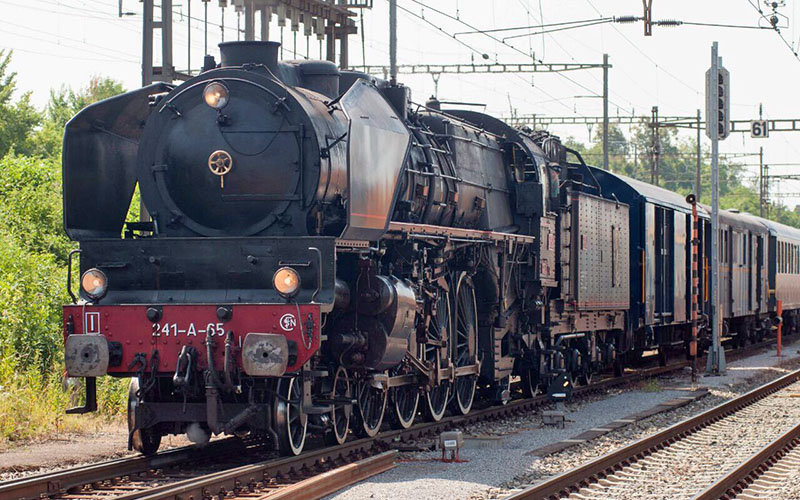
The 241 A 65 saw use on the French segment of the Arlberg Orient Express, which traveled from London to Bucharest where it split into two sections: one going to Istanbul, and the other going to Athens. The train in the 2017 movie was the Simplon Orient Express, which took a more southerly route, from Paris to Istanbul over the Simplon Pass in Switzerland. 241 A 65 with an excursion train at Koblenz, Switzerland, on August 23, 2009. — Andreas Lindner photo, John Menges collection
SNCF 241 A 65 was part of a larger class of 4-8-2 Mountain-type locomotives that were the first of their kind in Europe. Unlike in North America, 4-8-2s were rare in Europe, and they were used primarily for express passenger service. The French 241s were designed in the early 1920s by the Est (Chemins de fer de l’Est; East Railroad) Railroad, and a prototype locomotive was built in 1925 in the company shops at Epernay, France. The new Mountains would become the largest and most efficient steam locomotives in Europe for a time. They developed 3,540 horsepower and could reach a top speed of 75 mph. With a working weight of 200 tons, they stretched over 85 feet long. The 241 incorporated designs from renowned French locomotive designers Alfred de Glehn and Gaston du Bousquet.
The engineers borrowed the four-cylinder compound concept from de Glehn, where the first drive axle was driven by two low-pressure cylinders located in the frame over the leading truck, and the second drive axle was driven by two high-pressure cylinders located outside the frame and behind the leading truck. Du Bousquet’s ideas were integrated into the design by using a flexible sheet metal frame and installing servo motor rotary valves between the high-and low-pressure cylinders so that the engineer could admit high-pressure steam into the low-pressure cylinders and obtain quicker accelerations from stops. Each set of cylinders was controlled by separate Heusinger valve gears mounted on the left side of the locomotive — the engineer stood on the left-hand side of the cab. The cab roof and floor reflected Est design, with the floor extending all the way into a recess on the tender deck, omitting the usual hinged tender deck plate. The 241s featured double compound air pumps and Westinghouse air brakes, which acted on all axles of the locomotive and tender. Tenders for the 241 class were equipped with air-operated coal pushers, as well as water scoops for taking water on the fly from track pans halfway between Paris and the Atlantic coast.

After a period of testing and refinement, the 241 Mountain was ready to go into production, and Fives-Lille and SACM Graffenstaden built 89 locomotives between 1930 and 1934. Forty 241s went to the Est, and forty-nine 241s went to the État Railroad (Chemins de fer de l’État; State Railroads). Our sample model, 241 A 65, began life as État engine No. 241-001 on August 16, 1931. It was originally stationed at Batignolles near Paris but was re-assigned to the Cherbourg–Le Havre line in northwest France. Not long after the 241s were delivered to the État, they became dissatisfied with the Mountains because they were hard on their track, and all 49 were sold to the Est.
When the French railroads were nationalized and SNCF was created in 1938, the Est 241s were reclassified as 241 As and renumbered 241 A 001 to 241 A 90, with the former 241-001 becoming 241 A 65. During World War II, many SNCF locomotives were taken to Germany to be used on the Deutsche Reichsbahn, and 241 A 65 was captured and put to use in the Erfurt area. After the war, 241 A 65 was returned to France and stayed for a year at Le Mans before being transferred to Chaumont in eastern France, where she remained for nearly 20 years before retiring from active service on July 23, 1965. Instead of scrapping the locomotive, SNCF kept 241 A 65 as a boiler to supply steam to the workshops at Chaumont until May 1968.
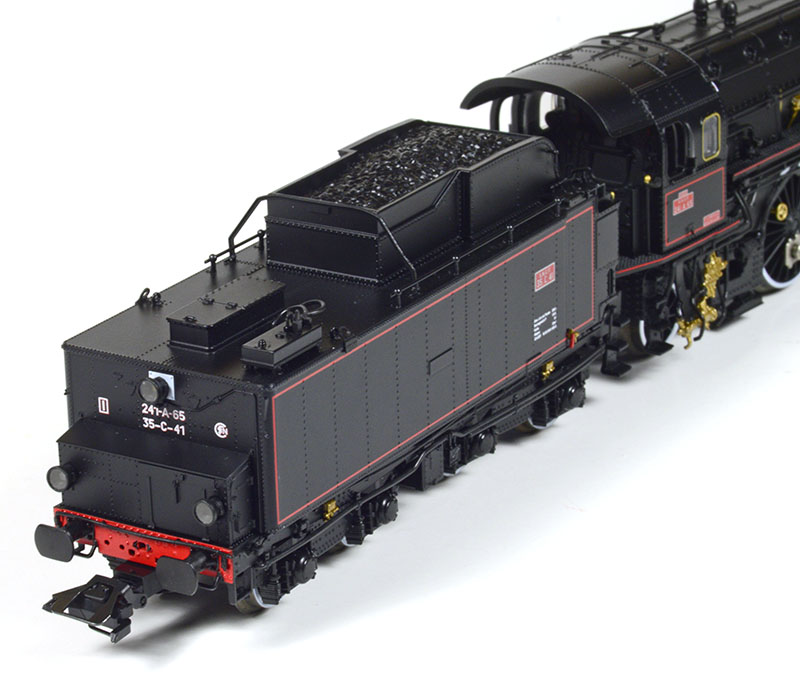
The story could have ended there, but a Swiss railfan by the name of Armin Glaser acquired the locomotive with the help of the Chaumont shops foreman and had it transported to Switzerland where it was cosmetically restored by the SBB (Swiss Federal Railroads) workshops in Zurich. From there, the locomotive was put on display at the Swiss Museum of Transport in Lucerne, and in 1982 it was moved to the Oswald Steam organization in Samstagen, Switzerland. In 1989 the Vapeur Val-de-Travers tourist railroad in St. Sulpice, Switzerland, took possession of the locomotive but was unable to undertake a complete restoration of the engine, so it found a sponsor in Mr. Urs Wettstein from Wettstein Refrigeration Systems of Gümligen, Switzerland, who in 1996 underwrote a complete rebuilding of 241 A 65 at the Meiningen Steam Locomotive Works in Germany. The locomotive was completed in a year and returned to operation on September 22, 1997. In April 2003, Mr. Wettstein offered 241 A 65 to the newly formed Verein 241 A 65 (Club 241 A 65), and since September 2008, the engine has been kept at their facility in Full-Reuenthal, Switzerland, for use in excursion service. At present, SNCF 241 A 65 is the largest operating hand-fired steam locomotive on European standard gauge rails. While not the biggest French steam locomotive, it is near the top. The only other surviving 241 A; 241 A 1, resides at the Cité du train museum in Mulhouse, France.
Märklin/Trix’s entirely new 241 A 65 is the first time a major manufacturer has released an SNCF 241 A in HO. Previously, 241 As have been available in brass from Lemaco in the 1990s and Micro-Metakit in 2000s. The Trix 241 A 65 comes to us in its current-day appearance as an excursion locomotive. During their working lives, the 241 As wore olive green and had only buffer beam headlights, per French practice. When 241 A 65 was refurbished, it received a black finish with red pinstriping, white wheel trim, gold accents, and a third headlight mounted on the smokebox door.

On removing the locomotive from its plastic clamshell cradle, the level of detail impressed me, as well as the contrast of gold, white, and red highlights against the satin black superstructure. The paint finish was uniform throughout the model with no smudges or uneven application, and all lettering was crisp and legible under magnification. The one-pound, three-ounce locomotive and tender are semi-permanently coupled together by an adjustable drawbar that is factory set to the wider spacing for placement in the clamshell cradle. Both engine and tender are predominantly die-cast metal, with numerous separately applied plastic and metal detail castings. The model features a full cab interior with illuminated gauges, but no crew figures are included, so you will have to supply your own from Preiser or Noch.
Trix’s 241 A 65 drive wheels are slightly smaller than the prototype 241 A 65’s six-foot, four-inch diameter drive wheels by three scale inches to accommodate flange depth, yet it runs smoothly on Code 83 track. Unlike the real 241 A 65, Trix’s HO-scale 241 A 65 does not have functional inside cylinders driving the first drive axle. While that would have been neat to see from the underside of the locomotive, it would have added considerable cost (and complication) to the model, and the inside drive is not readily visible on the prototype.

The locomotive comes with two styles of trailing truck sideframes: one for display and one with wider clearance for operation. To swap out the operational sideframe for the display sideframe, you just snap it out and snap in the other frame. Trix’s 241 A 65 utilizes a close coupler mechanism on the tender with a standard Märklin loop-and-hook coupler that can be changed out for any NEM close coupler, like a Kadee No. 18. No provision was made for a front coupler on the locomotive, which is kind of disappointing because 241 A 65 has sometimes run in-tandem with other restored steam locomotives.
The 241 A 65’s large Belpaire style firebox, common in France on deGlehn compounds, makes a generous clearance for a five-pole can motor and gearbox that powers the rear drive axle, which drives the other drivers via the side rods. I appreciate that the motor is located in the locomotive rather than in the tender like other European steam locomotive models, as I have had tender-driven locomotives’ drive wheels lock up during operation. Power is drawn from each wheel of the locomotive and tender via wipers.
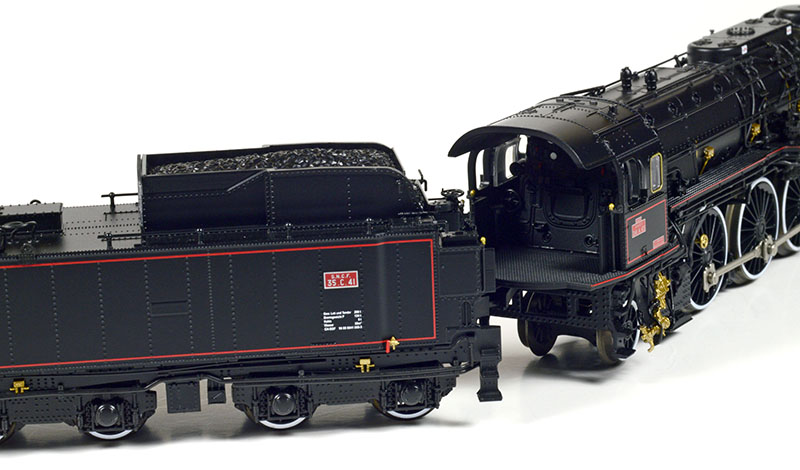
Note the power reverse on the left-hand side of the engine. In France, the engineer stands on the left-hand side — SNCF is left-hand running — as is the case in Switzerland.
Two small bags are included with the model. The parts bag contains brake and steam lines, as well as a dummy coupler for display models. The other bag contains logo decals for Wettstein Refrigeration Systems, which are attached to the side of 241 A 65’s tender. I put the Wettstein logos on two small squares of thin black styrene and glued them on the tender using canopy glue. Lastly, two owners manuals in eight different languages, as well as the warranty, are included with Trix’s 241 A 65. They are inserted in a cardboard sleeve that is thoughtfully recessed into a slot in the carton holding the model, so as not to interfere with removing the 241 A 65 from its box.
The Trix 241 A 65 uses a Märklin mfx multi-protocol decoder that will have to be entered into your Digital Command Control (DCC) system before operating the locomotive. Using my Piko Smart Control, I did this on the programming track. After entering the locomotive’s address, I was ready to test the 241 A 65. The locomotive ran flawlessly during an hour and a half of break-in time in both directions, save some static from the speakers experienced at higher speeds, which may have been the result of CVs that needed to be adjusted. Trix recommends a minimum 16-inch radius for operating the 241 A 65, so layouts with 18-inch curves or greater will be no problem for the locomotive. The locomotive began to crawl at speed step 1 and ran smoothly through speed step 28. There was little motor noise during silent operation and none that I could hear during sound operation. The 30 digital functions on the 241 A 65 add a lot of operational realism to this highly detailed steam locomotive.
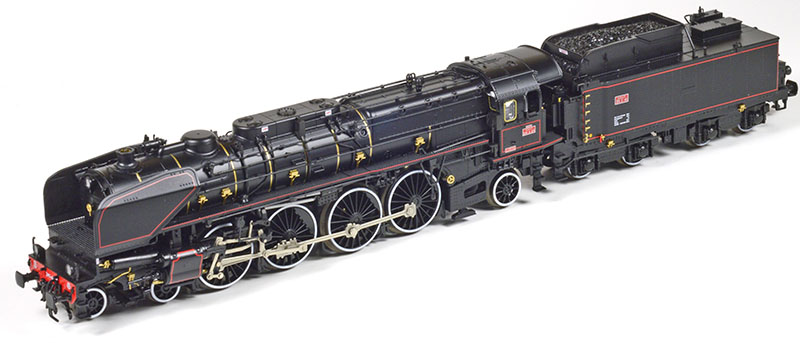
The outside cylinders were mounted over the rear axle of the leading truck, per de Glehn compounding practice. The inside low-pressure cylinders were mounted in the locomotive frame, centered over the leading truck.
The model features directional LED lighting, as well as illuminated cab gauges, cab lighting, and illuminated running gear — all via white LEDs. The model 241 A 65, like its prototype, uses two different whistles: one is a high-pitched European whistle, and the other is a North American-style whistle, which was installed on the locomotive when it was restored. In YouTube videos of the real 241 A 65, one will hear the North American-style whistle being frequently used on fan trips. Other sound functions include dynamo whir, water injector, coal loading, water fill, radio (in Swiss German), cylinder purge, etc. The Trix 241 A 65 features a smoke generator, but it is not a pulsating generator, which is something I would have expected on this high-end model. When testing the smoke unit, I used Piko Smoke and Cleaning Fluid (#36210), since it does not leave a residue on the model if it splatters. If there’s anything I’d like to see on this model, it would be a functional cylinder purge like on the REE 141 Mikado featured in the April 2018 Model Railroad News. Flickering smokebox light would be nice as well. One important thing to note: the mfx decoder in the 241 A 65 allows for running on analog DC layouts, but not all sound functions will operate in analog. The 241 A 65’s mfx decoder contains 30 functions, so unless you are using Märklin’s Central Station, you may not be able to access functions 29 and 30 without function mapping.
In the time since its release, the 241 A 65 has already become a collector’s piece and is commanding premium prices on eBay from what I’ve noticed. It’s a good-looking, good-running locomotive for a modern-era European layout running steam excursions. One might say it is like a Swiss version of Nickel Plate Road No. 765 since an association owns it (versus a railroad). In the future, we may well see other versions of these French 241s from Märklin/Trix, as they ran for three different French railroad administrations, as well as one that stayed in Germany after the war. Suitable HO coaches for the 241 A 65 from the 1930s to the present are available from Roco, REE Models, and LS Models, including CIWL (Orient Express) cars that were the type used in making the movie. The Trix 241 A 65 pulling a string of Orient Express sleeping cars would look good on any layout. It is a stately locomotive that looks like an engine that pulled trains frequented by the nobility.
Trix HO-scale
SNCF class 241-A Express Train steam locomotive
No. T22941, MSRP: $659.99
Trix, distributed by Märklin Inc.
P.O. Box 2649
Lake Ozark, MO 65049
573-365-9522
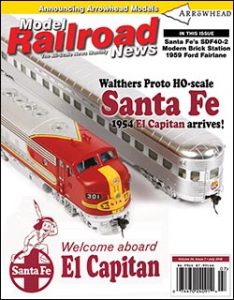 This review appeared in the July 2018 issue of Model Railroad News
This review appeared in the July 2018 issue of Model Railroad News



